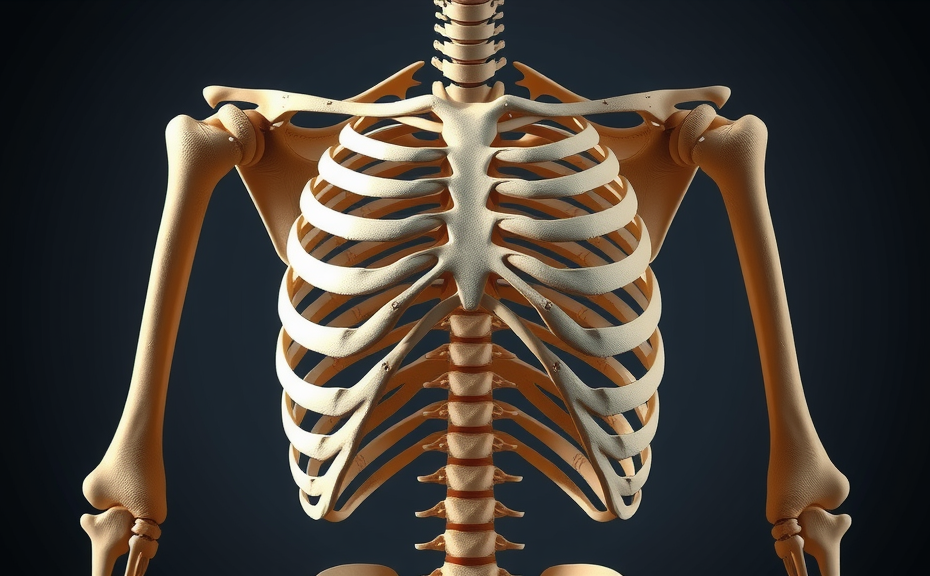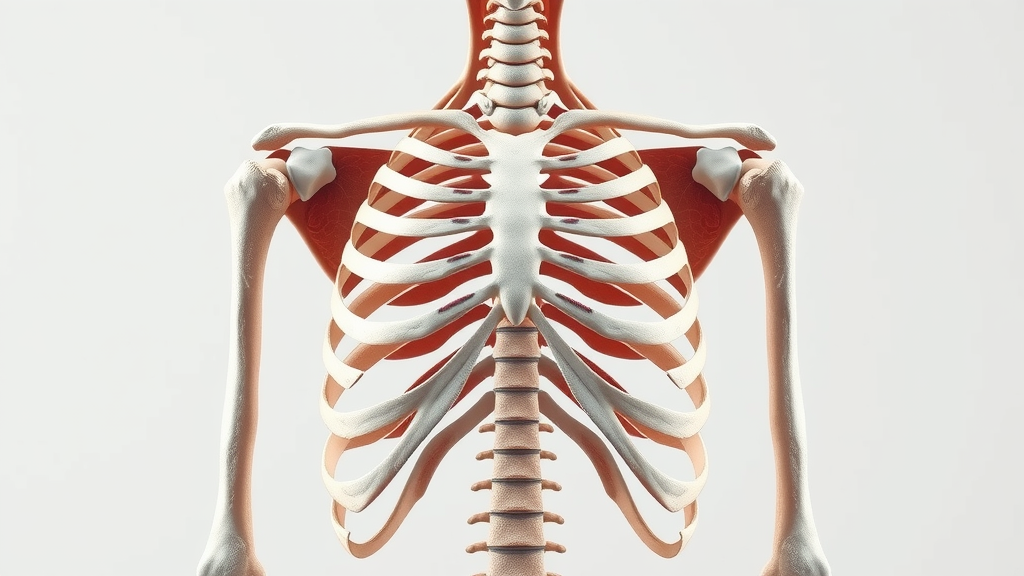The process of bone development in the human skeletal system reveals intriguing specifics regarding different types of ossification. Ribs are predominantly the result of endochondral ossification, wherein cartilage serves as a precursor to bone formation.
This essential transformation facilitates the structural integrity and functionality of ribs.
During embryonic development, mesenchymal tissue is the foundation from which cartilage forms, ultimately acting as a template for the ensuing bone.
While certain skull bones utilize intramembranous ossification, this method does not factor into the development of ribs. Such distinctions illuminate the role of the skeletal system in supporting respiratory activities and safeguarding internal organs.
Are Ribs Formed By Intramembranous Ossification
The development of the rib cage is an intricate biological process. Ribs are primarily formed through endochondral ossification, where mesenchyme, a type of connective tissue, first differentiates into cartilage.
This cartilage serves as a scaffold for further development.
As the embryo grows, osteoblasts, which are bone-forming cells, gradually replace the cartilage with bone tissue.
Ribs are categorized as flat bones, and their formation involves various critical stages, including the establishment of growth plates. Interestingly, while the majority of rib structure results from endochondral ossification, some areas may demonstrate alternative ossification patterns.
The periosteum, a dense layer of vascular connective tissue, is instrumental in facilitating this transformation and ensuring the ribs develop appropriately within the thoracic cavity.
Understanding Bone Formation In Ribs
The formation of ribs involves a series of complex cellular processes leading to the establishment of a bony structure. Initially, these structures arise as cartilage models through the chondrification process, where cells differentiate into chondrocytes.
Subsequently, this cartilage is replaced through ossification, transforming into ossified tissue over time.
Each pair of ribs develops from distinct segments, influenced by genetic factors, which contributes to their unique morphology.
The composition of ribs includes both compact bone, providing durability, and spongy bone, offering resilience and flexibility. Environmental factors like mechanical stress from respiration play a significant role in shaping their development and overall density.
The well-orchestrated stages of rib formation illustrate the complexity of rib anatomy and its importance in maintaining a functional skeletal system.
Rib Formation
- Ribs initially form as cartilage models through the chondrification process.
- The transformation from cartilage to bone occurs through ossification, leading to ossified tissue.
- Each pair of ribs develops from distinct segments, influenced by genetic factors, affecting their morphology.
- Environmental factors, such as mechanical stress from respiration, significantly influence rib development and density.
What Is Intramembranous Ossification
The formation of certain bones involves a process characterized by the direct conversion of mesenchymal cells into bone-producing cells. This method differs significantly from endochondral ossification, which relies on a cartilage precursor.
The journey begins when mesenchymal cells cluster together and differentiate into osteogenic cells, leading to the production of a bone matrix.
As these cells develop into osteoblasts, they secrete the matrix, which subsequently forms small bone spicules, integral for establishing a trabecular structure.
This process mainly occurs during embryonic development, particularly influential in the creation of flat bones such as the skull and ribs.
During this phase of skeletal maturity, the bones grow rapidly, defining their shape and strength. Fibroblasts contribute to the initial formation of the matrix, providing necessary structural support. A unique aspect of intramembranous ossification is its role in embryonic development, where osteogenic cells differentiate into bone-forming cells, contributing to the formation of the bone matrix, as opposed to the involvement of fibroblasts and chondrocytes in endochondral ossification, ultimately leading to skeletal maturity.
The Role Of Osteoblasts In Ribs
Bone formation and maintenance in the rib structure are primarily dependent on specialized cells responsible for synthesizing the bone matrix. These cells facilitate mineralization, which is important for ensuring rib strength and integrity.
During the early stages of endochondral ossification, a process in which cartilage is replaced by bone, these cells exhibit peak activity.
This remodeling allows the ribs to achieve their necessary shape and function.
Factors such as diet and exercise can significantly impact the activity of these cells, influencing overall rib health. Communication between osteoblasts and adjacent bone cells plays a significant role in ensuring the ongoing structural stability and functionality of the ribcage.
| Cell Type | Function |
|---|---|
| Osteoblasts | Synthesize the bone matrix and facilitate mineralization |
| Chondrocytes | Involved in the early stages of endochondral ossification |
| Diet and Exercise | Influence the activity of bone cells and overall rib health |
| Cell Communication | Ensures structural stability and functionality of the ribcage |
Ribs And The Skeletal System Anatomy
The human skeletal framework relies significantly on a series of curved structures known for their strength and flexibility. There are 24 ribs, categorized into three types: true ribs, false ribs, and floating ribs. True ribs, numbering seven pairs, attach directly to the sternum, while the next three pairs are classified as false ribs, connecting indirectly.
The last two pairs are floating ribs, which do not attach to the sternum at all.
Ribs exhibit a flat bone structure that is conducive to their function of protecting thoracic organs while allowing for slight movement during breathing.
During their development, ribs originate from mesoderm, influenced by various genetic factors.
The anatomy of ribs reveals their crucial relationship with the thoracic vertebrae and sternum, collectively forming the rib cage. This structure serves to protect the cranial vault, providing a flat bone structure with density that facilitates mechanotransduction through osteocytes derived from the mesoderm.
How Bone Matrix Affects Ribs
The intricate composition of bones plays a significant role in defining rib functionality and structure. Composed primarily of organic materials, such as collagen fibers, the matrix contributes to the ribs’ strength and flexibility.
Notably, this matrix undergoes mineralization, with hydroxyapatite accounting for about 70% of its weight.
This unique composition influences the ribs’ shape, facilitating a curvature that protects vital organs while allowing movement during respiration.
Ribs are not static; they experience ongoing remodeling throughout one’s life, affected by the quality and components of the matrix. This dynamic process reflects the ribs’ development from embryology through adulthood, showcasing how they adapt to various biomechanical properties.
Interestingly, the relationship between cartilage and bone growth plays a part in maintaining rib integrity, signifying the interconnected nature of these structures within the skeletal system.
| Composition Element | Percentage of Weight |
|---|---|
| Hydroxyapatite | 70% |
| Collagen Fibers | Primary Organic Material |
| Rib Functionality | Protects Vital Organs |
| Remodeling Process | Ongoing Throughout Life |
The Connection Between Cartilage And Bone Growth
The development of the skeletal system is a complex process, with a significant role played by flexible connective tissues. Cartilage acts as a precursor in forming various bones, particularly the ribs, which are integral to the thoracic cavity’s structure.
Through a fascinating process known as endochondral ossification, this tissue gradually transitions into bone.
In osteology, the transformation of cartilage into bone is recognized for its varying characteristics across different skeletal elements.
For instance, rib formation exhibits unique adaptations influenced by mechanical stress and nutritional factors, which are vital during pediatric growth. Interestingly, these transformations can provide insights into conditions affecting bone health, further emphasizing the importance of cartilage in rib formation.
The interplay between these tissues not only supports the structural integrity of the rib cage but also reflects broader evolutionary adaptations that enable efficient growth.
Are Ribs Considered Flat Bones
The skeletal framework plays an indispensable role in safeguarding organs located in the thoracic cavity. Ribs are characterized by their thin and flattened shape, a feature that positions them within the classification of flat bones.
Structurally, these elements primarily develop through endochondral ossification, a unique process whereby cartilage is transformed into bone.
This method of formation contributes to their ability to provide structural support while maintaining a degree of flexibility.
Anatomical variations among individuals can significantly influence rib structure, which may impact functionality and health outcomes. In the realm of orthopedic science, recognizing the classification of ribs is beneficial for enhancing radiological assessment in medical practice.
Ribs and Their Function
- Ribs serve to protect vital organs in the thoracic cavity, such as the heart and lungs.
- Ribs are classified as flat bones due to their thin and flattened shape.
- Endochondral ossification is the process through which ribs develop, allowing for a balance of support and flexibility.
- Anatomical variations in rib structure can affect individual health and functionality.

